All Exams >
EmSAT Achieve >
Physics for EmSAT Achieve >
All Questions
All questions of AC & DC Electric Circuits for EmSAT Achieve Exam
AC power is expressed as __________. (Where 'i'm amplitude of the AC current and 'R' is circuit resistance)- a)im2R
- b)im2R/2
- c)imR2/2
- d)imR2
Correct answer is option 'B'. Can you explain this answer?
AC power is expressed as __________. (Where 'i'm amplitude of the AC current and 'R' is circuit resistance)
a)
im2R
b)
im2R/2
c)
imR2/2
d)
imR2

|
Arien Instructors answered |
From the above explanation, we can see that power decapitated by any circuit can be expressed as

Whereas for A.C current the above expression can be expressed as

Hence option 2 is correct among all

Whereas for A.C current the above expression can be expressed as

Hence option 2 is correct among all
Alternating current cannot be measured by DC ammeter because:- a)Alternating current cannot pass through the DC ammeter
- b)Average value of complete cycle is zero
- c)Alternating current changes its direction
- d)None of these
Correct answer is option 'B'. Can you explain this answer?
Alternating current cannot be measured by DC ammeter because:
a)
Alternating current cannot pass through the DC ammeter
b)
Average value of complete cycle is zero
c)
Alternating current changes its direction
d)
None of these

|
Arien Instructors answered |
- The DC ammeter measures the mean value of current and the mean value of the AC current is zero, so we cannot measure the AC current by the DC ammeter.
- Hence, option 2 is correct.
A DC voltmeter is capable of measuring a maximum of 300 volts. If it is used to measure the voltage across a device operating at 220 volt AC supply, the reading of the voltmeter will be- a)0 volt
- b)330 volts
- c)110 volts
- d)220 volts
Correct answer is option 'A'. Can you explain this answer?
A DC voltmeter is capable of measuring a maximum of 300 volts. If it is used to measure the voltage across a device operating at 220 volt AC supply, the reading of the voltmeter will be
a)
0 volt
b)
330 volts
c)
110 volts
d)
220 volts

|
Arien Instructors answered |
- DC voltmeter can not measure AC voltages.
- When used in AC circuits, DC Voltmeter gives zero reading because the average value of alternating voltage over a full cycle is zero.
- So, the reading of the voltmeter will be 0 volts, as a DC voltmeter cannot be used for measuring AC potential difference as it is current direction oriented.
If the rms current in a 50 Hz ac circuit is 5 A, the value of the current 1/300 seconds after its value becomes zero is- a)5√2A
- b)5√3/2A
- c)5/6 A
- d)More than one of the above
Correct answer is option 'B'. Can you explain this answer?
If the rms current in a 50 Hz ac circuit is 5 A, the value of the current 1/300 seconds after its value becomes zero is
a)
5√2A
b)
5√3/2A
c)
5/6 A
d)
More than one of the above

|
Arien Instructors answered |
→ Equation for current and voltage for an A.C circuit can be written as:

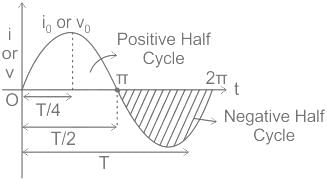
Where, i and V are instantaneous values of current and voltage.


Where, i and V are instantaneous values of current and voltage.
i0 and V0 are peak values of current and voltage.
ω = angular frequency in rad/sec
f = frequency in Hz
T = time period in sec.
Now, irms = i0/√2
⇒ i0 = irms × √2 = 5√2 A
∴ at t = 1/300 sec, and f = 50 Hz the current i will be,
⇒i = i0 sin (2πf)t = (5√2) sin (2π×50) (1/300)

So, the correct answer is option (2).
Now, irms = i0/√2
⇒ i0 = irms × √2 = 5√2 A
∴ at t = 1/300 sec, and f = 50 Hz the current i will be,
⇒i = i0 sin (2πf)t = (5√2) sin (2π×50) (1/300)

So, the correct answer is option (2).
Value of current in an A.C. circuit is I = 2cos(ωt+θ). The value of Irms is:- a)√2 A
- b)1/√2 A
- c)2A
- d)1/2 A
Correct answer is option 'A'. Can you explain this answer?
Value of current in an A.C. circuit is I = 2cos(ωt+θ). The value of Irms is:
a)
√2 A
b)
1/√2 A
c)
2A
d)
1/2 A

|
Arien Instructors answered |
Given - I = 2cos(ωt+θ)
- The value of I will be maximum when cos(ωt+θ) is maximum,
- The maximum value of cos(ωt+θ) = 1
Therefore,
⇒ Io = 2A
So,

Hence, option 1 is correct.
⇒ Io = 2A
So,

Hence, option 1 is correct.
In Alternating Current (AC), the direction and magnitude of the current varies- a)Randomly
- b)Periodically
- c)Exponentially
- d)Do not vary
Correct answer is option 'B'. Can you explain this answer?
In Alternating Current (AC), the direction and magnitude of the current varies
a)
Randomly
b)
Periodically
c)
Exponentially
d)
Do not vary

|
Arien Instructors answered |
- The electric current flows in two ways: Alternating current and Direct Current.
- Direct current flows only in one direction.
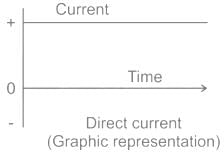
- Alternating current: The electric current whose direction changes periodically is called electric current.
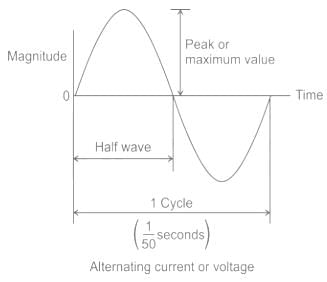
- Alternating current reverses its direction periodically.
- It also changes its magnitude periodically because of the induced electromagnetic force.
- For Alternating current both magnitude and direction change. The frequency of the alternating current in the Indian power supply is 50 Hz. The time period is 1/50 = 20 msec.
Which of the following value of current is minimum for the alternating current?- a)Peak value
- b)RMS value
- c)Mean value
- d)Peak value, RMS value and the mean value are equal for alternating current
Correct answer is option 'C'. Can you explain this answer?
Which of the following value of current is minimum for the alternating current?
a)
Peak value
b)
RMS value
c)
Mean value
d)
Peak value, RMS value and the mean value are equal for alternating current

|
Arien Instructors answered |
- The peak value of the alternating current is the maximum value attained by the alternating current.
- The RMS value of alternating current is given as,

- The mean value of alternating current is zero. So the mean value is minimum. Hence, option 3 is correct.
The average e.m.f. during the positive half cycle of an A.C. supply of peak value E0 is:- a)

- b)

- c)

- d)More than one of the above
Correct answer is option 'C'. Can you explain this answer?
The average e.m.f. during the positive half cycle of an A.C. supply of peak value E0 is:
a)

b)

c)

d)
More than one of the above

|
Arien Instructors answered |
For a positive half cycle, time period t = T/2
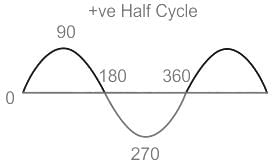
Then average e.m.f. during the positive half cycle of an A.C is
Eav (half cycle) = E/t
From equation 1 and 3
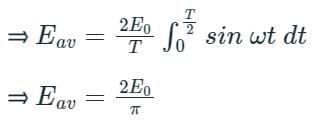

Then average e.m.f. during the positive half cycle of an A.C is
Eav (half cycle) = E/t
From equation 1 and 3

Alternating current cannot be measured by d.c ammeter because: - a)d.c ammeter get damaged
- b)average value of current over a complete cycle is zero
- c)a.c cannot pass through d.c ammeter
- d)a.c changes directions periodically
Correct answer is option 'B'. Can you explain this answer?
Alternating current cannot be measured by d.c ammeter because:
a)
d.c ammeter get damaged
b)
average value of current over a complete cycle is zero
c)
a.c cannot pass through d.c ammeter
d)
a.c changes directions periodically

|
Arien Instructors answered |
- In a dc ammeter, a coil is free to rotate in the magnetic field of a fixed magnet.
- If an alternating current is passed through such a coil, the torque will reverse its direction each time the current changes direction, and the average value of the torque will be zero.
- Hence, the average current value over a complete cycle is zero and the alternating current cannot be measured by the DC ammeter.
An ac voltage v = vm sinωt applied to a capacitor drives a current in the capacitor, i = ______________.- a)im sin(ωt - π/2)
- b)im sin(ωt - π)
- c)im sin(ωt + π)
- d)im sin(ωt + π/2)
Correct answer is option 'D'. Can you explain this answer?
An ac voltage v = vm sinωt applied to a capacitor drives a current in the capacitor, i = ______________.
a)
im sin(ωt - π/2)
b)
im sin(ωt - π)
c)
im sin(ωt + π)
d)
im sin(ωt + π/2)

|
Arien Instructors answered |
From the above explanation, we can see that for a pure capacitance circuit if AC voltage of v = vm sinωt then the driven current in the capacitor will be
I = im sin(ωt + ϕ)
Now as mentioned for pure inductor phase angle will be lagging by 90° or π/2.
i.e., ϕ = π/2 ⇒ i = im sin (ωt + π/2)
Chapter doubts & questions for AC & DC Electric Circuits - Physics for EmSAT Achieve 2025 is part of EmSAT Achieve exam preparation. The chapters have been prepared according to the EmSAT Achieve exam syllabus. The Chapter doubts & questions, notes, tests & MCQs are made for EmSAT Achieve 2025 Exam. Find important definitions, questions, notes, meanings, examples, exercises, MCQs and online tests here.
Chapter doubts & questions of AC & DC Electric Circuits - Physics for EmSAT Achieve in English & Hindi are available as part of EmSAT Achieve exam.
Download more important topics, notes, lectures and mock test series for EmSAT Achieve Exam by signing up for free.
Physics for EmSAT Achieve
208 videos|329 docs|212 tests
|

Contact Support
Our team is online on weekdays between 10 AM - 7 PM
Typical reply within 3 hours
|
Free Exam Preparation
at your Fingertips!
Access Free Study Material - Test Series, Structured Courses, Free Videos & Study Notes and Prepare for Your Exam With Ease

 Join the 10M+ students on EduRev
Join the 10M+ students on EduRev
|

|
Create your account for free
OR
Forgot Password
OR
Signup to see your scores
go up within 7 days!
Access 1000+ FREE Docs, Videos and Tests
Takes less than 10 seconds to signup









